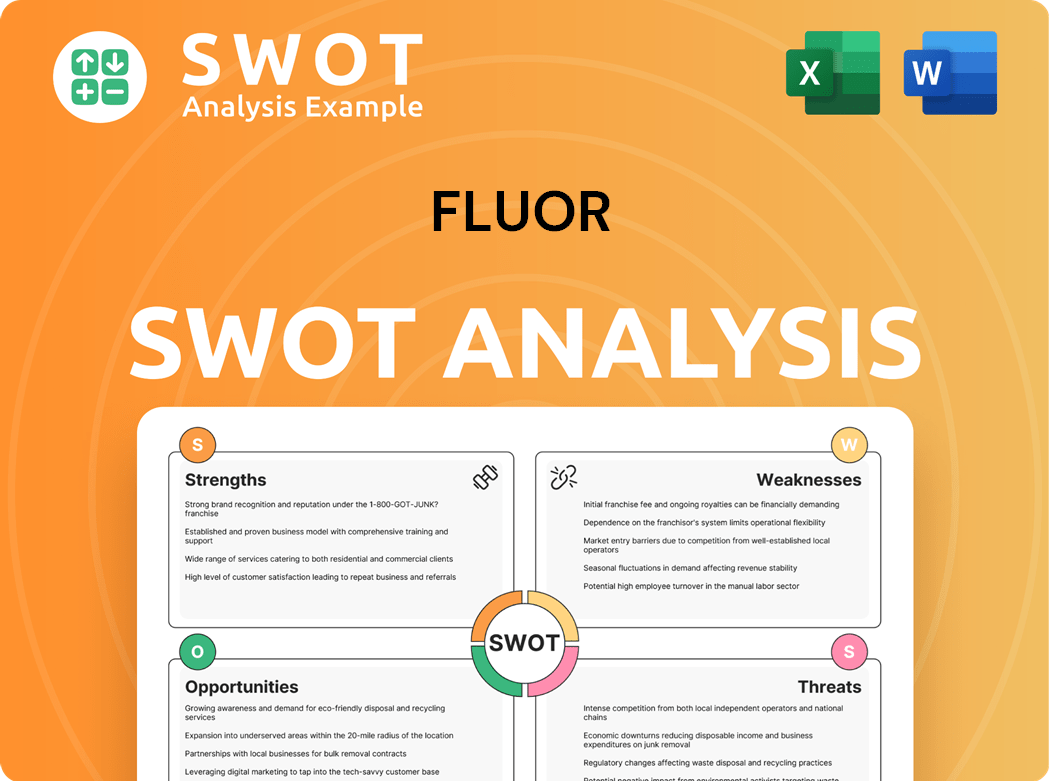Fluor Bundle
Who Really Owns Fluor Corporation?
Understanding the ownership structure of a company is crucial for investors and stakeholders alike. The direction of a global engineering and construction giant like Fluor Corporation is heavily influenced by its ownership. Knowing who holds the power provides critical insights into its strategic vision and future performance.

This deep dive into Fluor SWOT Analysis will uncover the evolution of Fluor ownership, from its inception to its current status. We'll examine the influence of major Fluor shareholders, explore the impact of Fluor executives, and analyze how the company's financial performance is intertwined with its ownership dynamics. Whether you're curious about Fluor stock or seeking a comprehensive Fluor Corporation investor relations overview, this analysis will provide valuable insights.
Who Founded Fluor?
The story of Fluor Corporation begins in 1912 with John Simon Fluor, who founded Fluor Construction Company in Santa Ana, California. This marked the official start of what would become a global engineering and construction giant. Before establishing the company, John Simon Fluor and his brothers had already gained experience in the saw and paper mill business, laying the groundwork for their future endeavors.
John Simon Fluor's initial investment in the business was modest, beginning with a personal contribution of $100. By 1924, the company had grown significantly, with annual revenues reaching $100,000 and a workforce of 100 employees. This growth led to the incorporation of the business with a $100,000 capital investment. The leadership was then passed on to his sons, Peter and Simon Fluor, who played crucial roles in the company's expansion.
Peter Fluor, as head of sales, played a vital role in boosting the company's revenues to $1.5 million by 1929. In that same year, the company was reincorporated as Fluor Corporation, Ltd., reflecting its broader scope beyond construction. This reincorporation also presented an opportunity for Fluor employees to purchase Fluor stock, indicating an early effort to involve employees in the company's ownership.
John Simon Fluor founded the company in 1912 in California.
The initial investment was $100.
By 1924, revenues reached $100,000 annually.
Employees were offered the chance to purchase Fluor stock during reincorporation.
The company expanded beyond construction, leading to the reincorporation as Fluor Corporation, Ltd.
Peter Fluor and J. Simon Fluor, Jr. played crucial roles.
The early history of Fluor Corporation highlights the foundational role of John Simon Fluor and his family in establishing and expanding the company. The transition from a construction company to a broader engineering and construction firm, as reflected in the 1929 reincorporation, marked a significant step in its evolution. Early efforts to involve employees in Fluor ownership, such as offering Fluor stock, suggest a forward-thinking approach to corporate governance. For more insights into the company's strategic direction, consider exploring the Marketing Strategy of Fluor.
- John Simon Fluor founded the company in 1912.
- Revenues grew to $1.5 million by 1929.
- Early ownership included family and employees.
- The company expanded beyond construction.
Fluor SWOT Analysis
- Complete SWOT Breakdown
- Fully Customizable
- Editable in Excel & Word
- Professional Formatting
- Investor-Ready Format

How Has Fluor’s Ownership Changed Over Time?
The journey of the Fluor Corporation, or Fluor company, from its inception to its current status as a publicly traded entity is a significant aspect of its history. Initially operating as a privately held enterprise, Fluor's ownership structure underwent a pivotal shift when its stock began trading over the counter in 1950. This transition marked the beginning of its evolution into a publicly accessible investment opportunity. The company then listed on the New York and Pacific exchanges by 1957, broadening its investor base and increasing its visibility in the financial markets. For a deeper dive into the company's origins, consider exploring the Brief History of Fluor.
As of June 11, 2025, Fluor Corporation (NYSE: FLR) has a market capitalization of a substantial $7.32 billion. The ownership landscape of Fluor is currently dominated by institutional investors, who hold a significant portion of the company's shares. Institutional ownership remained largely unchanged at 92.54% in May 2025, reflecting a stable investor base. This stability is a key indicator of investor confidence in the company's long-term prospects and strategic direction.
| Shareholder | Shares Held (as of March 31, 2025) | Percentage of Ownership |
|---|---|---|
| BlackRock, Inc. | 21,797,688 | Not specified |
| Vanguard Group Inc. | 17,159,858 | Not specified |
| Wellington Management Group Llp | 13,191,400 | Not specified |
| Fmr Llc | 6,917,321 | Not specified |
| State Street Corp | 6,438,651 | Not specified |
The shifts in institutional holdings during the fourth quarter of 2024 provide insights into investor sentiment. While some institutional investors increased their positions, others reduced their holdings. For example, Citadel Advisors LLC increased its holdings significantly, adding 1,694,945 shares, whereas Wellington Management Group LLP reduced its portfolio by 20.6%, removing 2,722,107 shares. The financial performance of Fluor in 2024, with revenue reaching $16.3 billion and a net income of $2.1 billion, underscores the company's robust financial health. The company's backlog of $28.5 billion further supports its strong market position and future growth potential.
Fluor Corporation's ownership structure is largely influenced by institutional investors, who hold a significant percentage of the company's shares.
- Institutional investors hold a significant portion of Fluor's shares, reflecting confidence in the company.
- Major institutional shareholders include BlackRock, Vanguard, and Wellington Management.
- The company's robust financial performance, including $16.3 billion in revenue and a $2.1 billion net income in 2024, supports its market position.
- Changes in institutional holdings reflect evolving investor sentiment and strategic decisions.
Fluor PESTLE Analysis
- Covers All 6 PESTLE Categories
- No Research Needed – Save Hours of Work
- Built by Experts, Trusted by Consultants
- Instant Download, Ready to Use
- 100% Editable, Fully Customizable

Who Sits on Fluor’s Board?
The direction of Fluor Corporation, a prominent player in the engineering and construction sector, is overseen by its Board of Directors, elected by the company's shareholders. As of April 30, 2025, the Board comprised eleven directors. Key figures include David E. Constable, who transitioned from Chairman and CEO to Executive Chairman on May 1, 2025, and Jim Breuer, who took over as Chief Executive Officer on the same date. Both Constable and Breuer are also directors. The board also includes Charles Blankenship, appointed in 2025, and Lisa Glatch, who joined the board in January 2024. The company's structure ensures that the board is responsible for the management of the company, approving senior management selections, and overseeing their performance, ensuring a robust governance framework.
The company's governance emphasizes a substantial majority of independent directors on the board, adhering to New York Stock Exchange listing standards. Independent directors play a crucial role in overseeing executive compensation, succession planning, risk assessment, corporate governance, and financial integrity. This structure is designed to protect the interests of Fluor shareholders and maintain the company's financial health. Understanding Fluor ownership structure is key for investors and stakeholders alike. For further insights into the company's operations, consider exploring the Revenue Streams & Business Model of Fluor.
| Director | Title | Appointed |
|---|---|---|
| David E. Constable | Executive Chairman | May 1, 2025 |
| Jim Breuer | Chief Executive Officer | May 1, 2025 |
| Charles Blankenship | Director | 2025 |
| Lisa Glatch | Director | January 2024 |
Fluor Corporation operates under a one-share-one-vote structure, ensuring that all common stockholders have equal voting rights on matters brought to a vote. This structure is a standard practice designed to provide all shareholders with a fair say in the company's decisions. Directors are elected by a majority of votes cast in uncontested elections.
- The Board oversees the company's management.
- Independent directors manage executive compensation and risk assessment.
- The company adheres to New York Stock Exchange listing standards.
- The company's governance structure protects shareholder interests.
Fluor Business Model Canvas
- Complete 9-Block Business Model Canvas
- Effortlessly Communicate Your Business Strategy
- Investor-Ready BMC Format
- 100% Editable and Customizable
- Clear and Structured Layout

What Recent Changes Have Shaped Fluor’s Ownership Landscape?
Recent developments at Fluor Corporation, a major player in the engineering and construction industry, showcase significant shifts in its leadership and financial strategies. In May 2025, Jim Breuer took over as Chief Executive Officer, with David E. Constable transitioning to Executive Chairman. This leadership change, coupled with the appointment of John C. Regan as Chief Financial Officer in March 2025, signals a strategic realignment within the company. These moves are crucial for understanding the future of Fluor ownership and its strategic direction.
Fluor has been actively managing its capital structure, particularly through share repurchase programs. The company repurchased $125 million worth of shares in Q4 2024. For 2025, Fluor plans to repurchase an additional $300 million in shares, with an accelerated repurchase of $142 million in Q1 2025. The company's commitment to returning value to shareholders reflects a positive outlook on its financial health and strategic positioning. Understanding the dynamics of Fluor stock is key for investors.
| Metric | 2024 | 2025 (Projected) |
|---|---|---|
| Revenue | $16.3 Billion | N/A |
| Net Income | $2.1 Billion | N/A |
| Operating Cash Flow | $828 Million | N/A |
| Backlog | $28.5 Billion | N/A |
| Adjusted EBITDA | N/A | $575 - $675 Million |
| Adjusted EPS | N/A | $2.25 - $2.75 |
Financially, Fluor demonstrated robust performance in 2024, with a revenue of $16.3 billion and a net income of $2.1 billion. The company's operating cash flow reached $828 million, the highest since 2015. Despite a decrease in new awards, the company's backlog remains substantial at $28.5 billion, with a significant portion being reimbursable. This shift towards a risk-balanced portfolio, alongside the company's strategic focus on data centers, mining, and LNG projects, highlights Fluor's proactive approach to growth. For more insights into Fluor's strategic approach, consider reading about the Growth Strategy of Fluor.
Jim Breuer assumed the role of CEO in May 2025, succeeding David E. Constable.
Fluor projects an adjusted EBITDA between $575 million and $675 million and an adjusted EPS between $2.25 and $2.75.
Fluor is targeting $300 million in share repurchases for 2025, with an accelerated $142 million in Q1 2025.
Fluor reported a revenue of $16.3 billion for the year 2024.
Fluor Porter's Five Forces Analysis
- Covers All 5 Competitive Forces in Detail
- Structured for Consultants, Students, and Founders
- 100% Editable in Microsoft Word & Excel
- Instant Digital Download – Use Immediately
- Compatible with Mac & PC – Fully Unlocked

Related Blogs
- What are Mission Vision & Core Values of Fluor Company?
- What is Competitive Landscape of Fluor Company?
- What is Growth Strategy and Future Prospects of Fluor Company?
- How Does Fluor Company Work?
- What is Sales and Marketing Strategy of Fluor Company?
- What is Brief History of Fluor Company?
- What is Customer Demographics and Target Market of Fluor Company?
Disclaimer
All information, articles, and product details provided on this website are for general informational and educational purposes only. We do not claim any ownership over, nor do we intend to infringe upon, any trademarks, copyrights, logos, brand names, or other intellectual property mentioned or depicted on this site. Such intellectual property remains the property of its respective owners, and any references here are made solely for identification or informational purposes, without implying any affiliation, endorsement, or partnership.
We make no representations or warranties, express or implied, regarding the accuracy, completeness, or suitability of any content or products presented. Nothing on this website should be construed as legal, tax, investment, financial, medical, or other professional advice. In addition, no part of this site—including articles or product references—constitutes a solicitation, recommendation, endorsement, advertisement, or offer to buy or sell any securities, franchises, or other financial instruments, particularly in jurisdictions where such activity would be unlawful.
All content is of a general nature and may not address the specific circumstances of any individual or entity. It is not a substitute for professional advice or services. Any actions you take based on the information provided here are strictly at your own risk. You accept full responsibility for any decisions or outcomes arising from your use of this website and agree to release us from any liability in connection with your use of, or reliance upon, the content or products found herein.